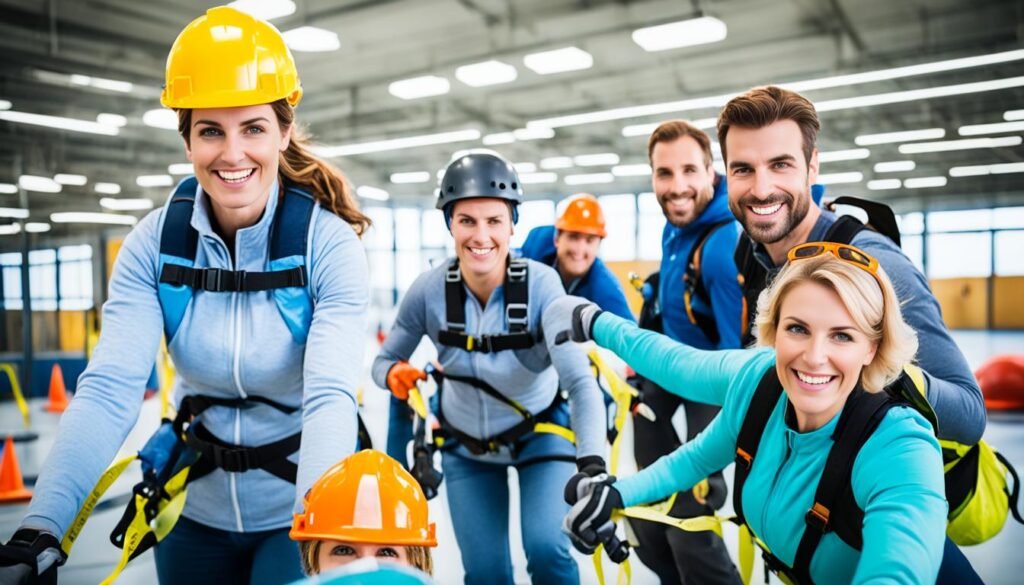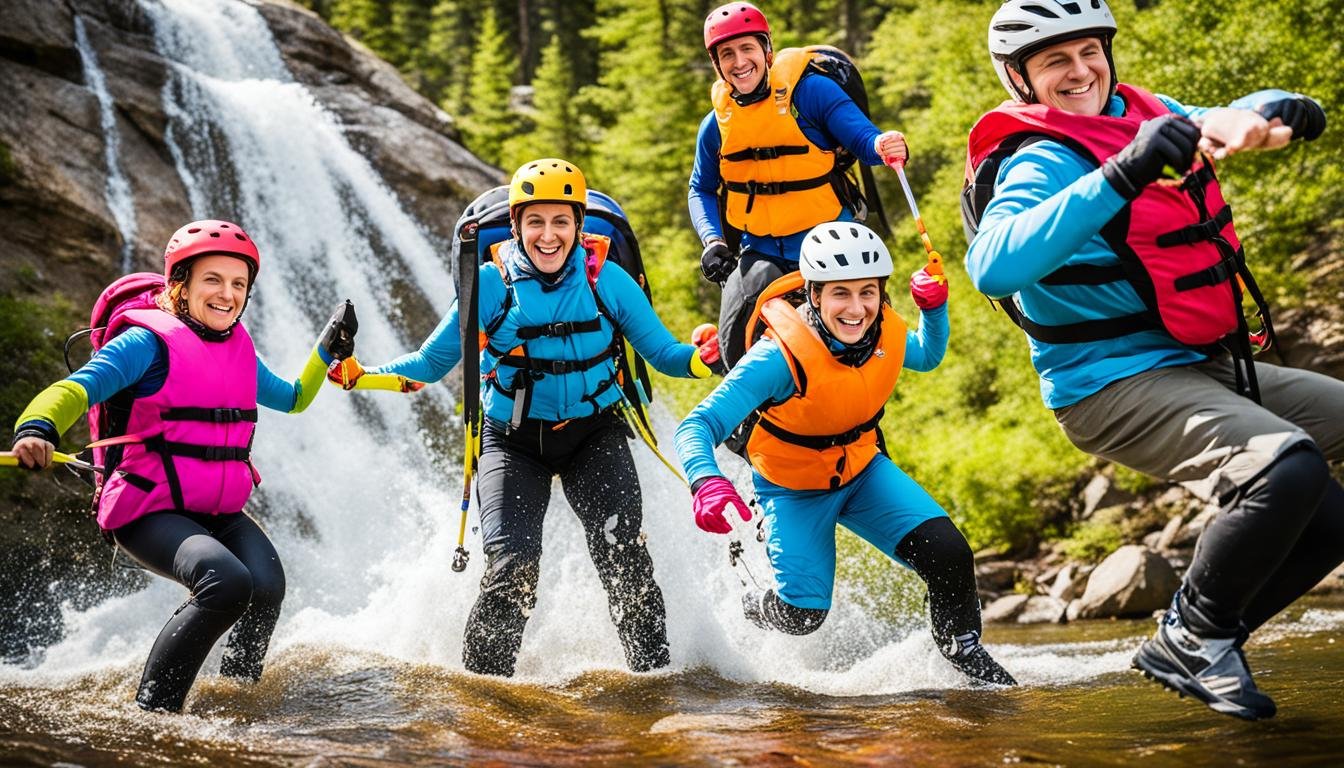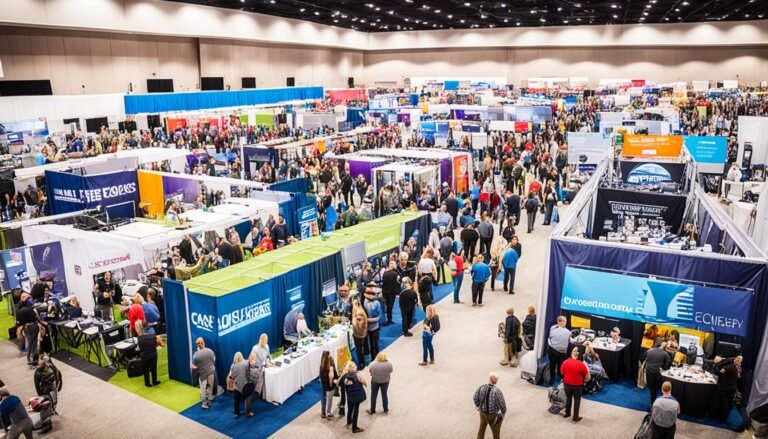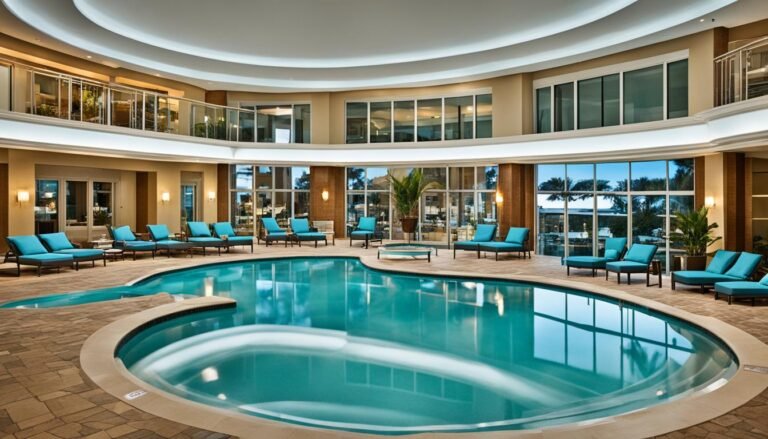Exploring Leisure & Recreation Management Basics
Welcome to the world of Leisure and Recreation Management! In this field, we look after leisure activities and facilities. These include tourism, sports, arts, and outdoor adventures. This job might involve making fun programs, running facilities, or working with different groups.
Picture a busy amusement park on a warm summer day. You see families having fun, kids laughing, and the smell of popcorn. But, behind the fun is a dedicated team. They plan attractions, sort out who works when, and keep things safe. Their hard work helps make the park a great place to visit.
This field is more than just fun. It’s about knowing how the leisure industry works. This means using the best ways to plan fun and oversee activities. Doing this can help people and communities feel happier, healthier, and more connected.
We’ll look at how to plan programs and run facilities in this article. These are crucial for making great leisure activities. So, get ready to learn more about Leisure and Recreation Management!
Key Takeaways:
- Knowing about leisure management principles is key to running leisure and recreation well.
- Planning recreational activities well is important for fun and inclusion.
- Making sure recreation places are safe, easy to get to, and fun is crucial.
- Handling money and resources well is vital for keeping leisure and recreation going.
- Talking with the community and working with others are crucial for meeting people’s leisure needs.
Understanding Impacts and Management
Managing leisure and recreation involves watching how it changes the environment. The activities we do can shift parts of nature. So, it’s key for leaders to curb these changes and lessen the harm. They do this by changing what affects how these changes happen. We’ll look at main change ideas, impacts that stop on their own, and the need to set clear boundaries on change.
Recreational use affects the environment in good and bad ways. It’s vital to know these effects to practice and spread green actions. Impact from having fun outdoors can mean:
- Physical impacts: These include changes to the landscape, erosion, and habitat destruction.
- Ecological impacts: Recreational activities can disturb wildlife and disrupt ecosystems.
- Social impacts: Increased visitation can lead to overcrowding, conflicts between user groups, and degradation of the visitor experience.
Many things can shape how big and where these impacts are. These include:
- Visitor behavior and numbers: What visitors do and how many there are can greatly affect nature.
- Infrastructure and facilities: Places where people can do recreation, like trails and parking, can focus impacts.
- Environmental sensitivity: Some places are more fragile to these changes, like rare ecosystems and homes for wildlife.
To limit the impact, good management is essential. Strategies to react include:
- Visitor education and awareness: Teaching guests about how their actions can help or harm nature encourages better choices.
- Trail design and maintenance: Trails that are well-planned and kept up can stop erosion and save delicate areas.
- Capacity management: This means setting visitor caps or having permits to keep how many are there in check.
- Monitoring and research: Keeping up with impacts and studying them closely are key to making smart management decisions.
Through understanding and applying good management, leaders in recreation can keep the fun going in the long run. They ensure nature stays safe and healthy.
Quote:
“The management of recreational impacts is essential for preserving the natural environment and ensuring the sustainable enjoyment of recreational activities.”
| Management Strategy | Description |
|---|---|
| Visitor Education and Awareness | Educating visitors about the impacts of their actions and promoting responsible behavior. |
| Trail Design and Maintenance | Designing and maintaining trails to minimize erosion and protect sensitive habitats. |
| Capacity Management | Implementing visitor limits or permit systems to control the number of visitors. |
| Monitoring and Research | Regular monitoring and research to gain insights into the impacts of recreational use. |
Planning for Effective Management
Proper planning is key in leisure and recreation management. Managers use planning concepts to run recreational activities well. The Recreation Opportunity Spectrum (ROS) and the Limits of Acceptable Change (LAC) are two common frameworks.
The ROS categorizes recreational options based on activities and experiences. It helps managers see the range of activities and what different people enjoy. This way, they can offer a mix of activities, balancing both active and chill options.
The LAC approach sets limits on how much an environment can change. It considers the capacity for visitors, the state of nature, and cultural issues. This approach aims to keep recreational places special, without harming their natural and cultural beauty.
Planning frameworks like the Recreation Opportunity Spectrum (ROS) and the Limits of Acceptable Change (LAC) are invaluable tools for leisure and recreation managers. By using these frameworks, managers can ensure a diverse range of recreational opportunities while minimizing negative impacts.
By using these planning tools, managers can create fun spots for people while protecting the environment. Good planning keeps the balance between fun and caring for nature. This way, everyone can enjoy leisure spots for a long time.
Program Planning and Design
Creating successful leisure activities involves more than fun. It’s about designing events that meet people’s needs and wants. When planning, we think about the audience, our goals, and how to make the events inclusive and exciting.
There are key steps to making a program shine. We start by learning what people really want. We chat with them, use surveys, and study trends to make sure we’re on track.
Next, teamwork is essential. We work closely with the community and local groups. This helps our programs fit the local culture and resources better, making them more successful.
Thinking outside the box is also crucial. We aim to create activities that stand out and stay memorable. This might mean using new tech, different locations, or fresh ideas.
It’s also vital that everyone can join in. Our events should be open to all, no matter their abilities or backgrounds. We make adaptations, change formats, and diversify the program to welcome everyone.
Getting people involved is another key. We want our programs to be hands-on, where everyone can take part. This can mean games, talks, learning by doing, or simply doing things together.
Evaluating our programs is as important as planning them. This step helps us see what worked and what didn’t. We listen to feedback, watch how things go, and study the data to keep getting better.
Example Program Planning and Design Strategies:
“First, we surveyed folks to find their favorite activities. Then, we teamed up with artists and musicians to bring outdoor concerts to the parks. Our goal was to make these events family-friendly and open to all. We constantly evaluated our work, which kept making our events even better suited to the community.”
| Benefit | Explanation |
|---|---|
| Engagement | A well-designed program captures participants’ interest and encourages active engagement. |
| Diversity | Inclusive program planning ensures that activities cater to a wide range of participants, creating an enriching and diverse experience. |
| Impact | Program evaluation allows managers to measure the impact of their programs and make data-driven decisions for continuous improvement. |
| Community Connection | Collaboration and engagement with the community foster a sense of connection and ensure that programs align with local values and needs. |
Managing Recreation Facilities

Running recreation areas is crucial for leisure time and fun. Managers are key in making sure places like parks and stadiums are top-notch. They work to keep these areas safe, fun, and in great shape for everyone to enjoy.
Facility Management Principles
Good management is based on several key points. These include mainly taking care of places, using resources well, and following rules. By focusing on these, managers keep places running well for a long time.
Facility Maintenance
Keeping places tidy and safe is a must-do. This means checking things often, fixing what’s broken, and upgrading as needed. Doing this regularly helps keep sports fields and parks safe and pretty for guests.
User Experience
Having fun starts with making sure visitors enjoy their time. Managers think about what guests like so they can have a blast. Adding things like sitting areas and food stands makes visitors happy. Listening to what guests say helps to make things even better.
Safety Considerations
Nothing is more important than keeping people safe. Managers lead in making places secure. They do this with checks, emergency plans, and helpful signs. This keeps everyone safe while they have fun.
Good management means focusing on care, fun, and safety. By sticking to these, managers make places where people and communities have a great time together.
Funding and Resource Management
Getting enough funds is critical for the success of leisure and recreation projects. Managers must find different ways to get funds. This includes getting help from the government, finding private sponsors, and charging user fees.
Using resources wisely is also very important. It’s key to make the most out of what they have. This way, they can offer better programs and meet people’s needs.
“Proper funding and resource allocation are crucial for our work. They help us offer great fun activities and make sure we can keep doing it for a long time.”
Budgeting is crucial. It’s all about planning and managing money for the projects. With a good budget, managers can use money in the best way possible. This means every dollar counts.
Types of Funding Sources
There are many ways to get funds for leisure and recreation programs. Some ways are through government grants, private sponsors, and fees from users.
- Government grants: These are funds from different government departments to help with fun activities. But, they have specific rules.
- Private sponsorships: Sponsoring companies can help by giving funds in return for some promotion of their brand.
- User fees: Money collected from people using certain activities can also help.
It’s smart to get money from many sources. This way, projects become more stable financially.
Ensuring Sustainability and Long-Term Success
Keeping things going strong over time is very important. Projects should be good for the economy, the environment, and the community.
If they spend money wisely and use resources well, projects can last a long time. Smart money management is key for this.
Community Engagement and Stakeholder Collaboration
Community and stakeholder involvement are crucial for managing leisure and recreation well. Engaging them ensures the activities meet the community’s needs and preferences.
When people express their thoughts, it helps managers understand what’s important. This feedback improves the programs and facilities, making the community feel involved and valued.
Partnerships between public and private groups also make things better. Working together brings new ideas and better services for everyone.
Collaboration between different groups leads to stronger, more inclusive leisure and recreation areas.
Working closely with the community and stakeholders benefits everyone. It makes leisure activities support health, social ties, and community well-being. This is good for the whole area.
It also boosts the local economy by drawing in visitors and helping nearby businesses. By teaming up with local groups and companies, more funding and resources become available for improving these offerings.
Benefits of Community Engagement and Stakeholder Collaborations:
- Improved decision-making and program development
- Enhanced understanding of community needs and preferences
- Increased social and community cohesion
- Access to additional funding and resources
- Strengthened relationships between different sectors
- Promotion of inclusivity and diversity
By focusing on community engagement and working closely with stakeholders, managers can create welcoming and lasting places. These places consider and meet the varied needs of everyone.
| Types of Stakeholders | Examples |
|---|---|
| Local government | City council members, park and recreation department officials |
| Community organizations | Non-profit organizations, sports clubs, advocacy groups |
| Private businesses | Sponsors, vendors, tourism operators |
| Residents | Community members, individuals using recreational facilities |
Current Trends and Innovations
The world of leisure and recreation is always changing. New trends and technology mix with practices that help the planet. Plus, there is a big push to include everyone. To lead well, managers must keep up with these shifts. This way, they can offer great leisure times and meet the visitors’ changing needs.
Embracing Technology for Enhanced Leisure Management
Technology is changing how we enjoy our free time. Think online bookings and cool apps. Also, virtual reality lets us try new things from anywhere. These tech changes make fun activities easier to get into and more personal. For managers, tech means they can work smoother, talk better, and reach out widely.
Advancing Sustainable Practices for a Greener Future
Being green is super important in the leisure world now. People care more about how fun affects our planet. To help, managers are going eco. They use energy better, cut down on waste, and build in green ways. This focus on being kind to Earth keeps enjoyment alive for years to come.
Promoting Inclusivity for Diverse Participation
Leisure is for everyone, and the industry knows it. Places and programs are set up to welcome all. Managers make sure their spots are easy to use and their teams respect all differences. This way, all visitors feel they belong and can have fun without barriers.
“The integration of technology, advancement of sustainable practices, and promotion of inclusivity are shaping the future of leisure and recreation management.”
Change keeps coming in leisure. To keep up, managers must know what’s new and what works. This means using tech well, caring for the environment, and making sure everybody feels at home. By doing this, they make lasting memories for their visitors.
| Emerging Trends | Technology in Leisure Management | Sustainable Practices | Inclusivity |
|---|---|---|---|
| Virtual reality experiences | Online booking systems | Energy-efficient facilities | Accessible facilities |
| Adventure-based leisure activities | Mobile apps for program information | Waste reduction and recycling | Inclusive program design |
| Wellness and mindfulness programs | Social media engagement | Sustainable design principles | Diversity and inclusion training |
Conclusion
Leisure and recreation management is all about careful planning and using resources well. It also involves getting the community involved. This way, managers can make sure there are plenty of fun, diverse, and lasting leisure activities for everyone.
This article talked about some key points in leisure and recreation management. We explored how these activities can affect the environment. Plus, why having a solid plan is essential. We also looked at how to design programs, maintain facilities, manage money, and work with the community.
The leisure world is always changing. Managers need to keep up with new trends, technologies, and ways to be sustainable. By doing this and forming strong relationships, managers can make great things happen. They can make the leisure experience better for everyone, offering fun yet sustainable options.







